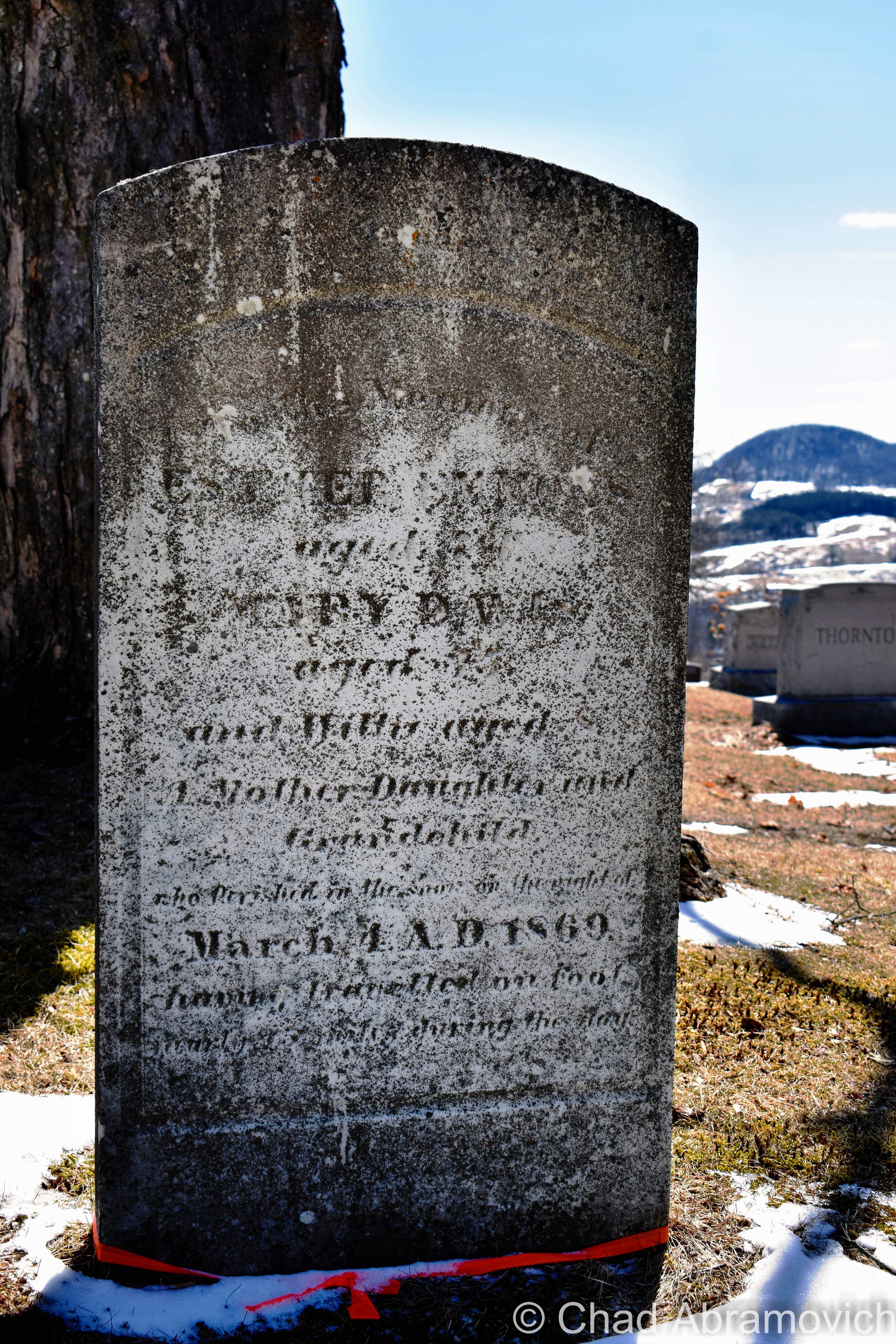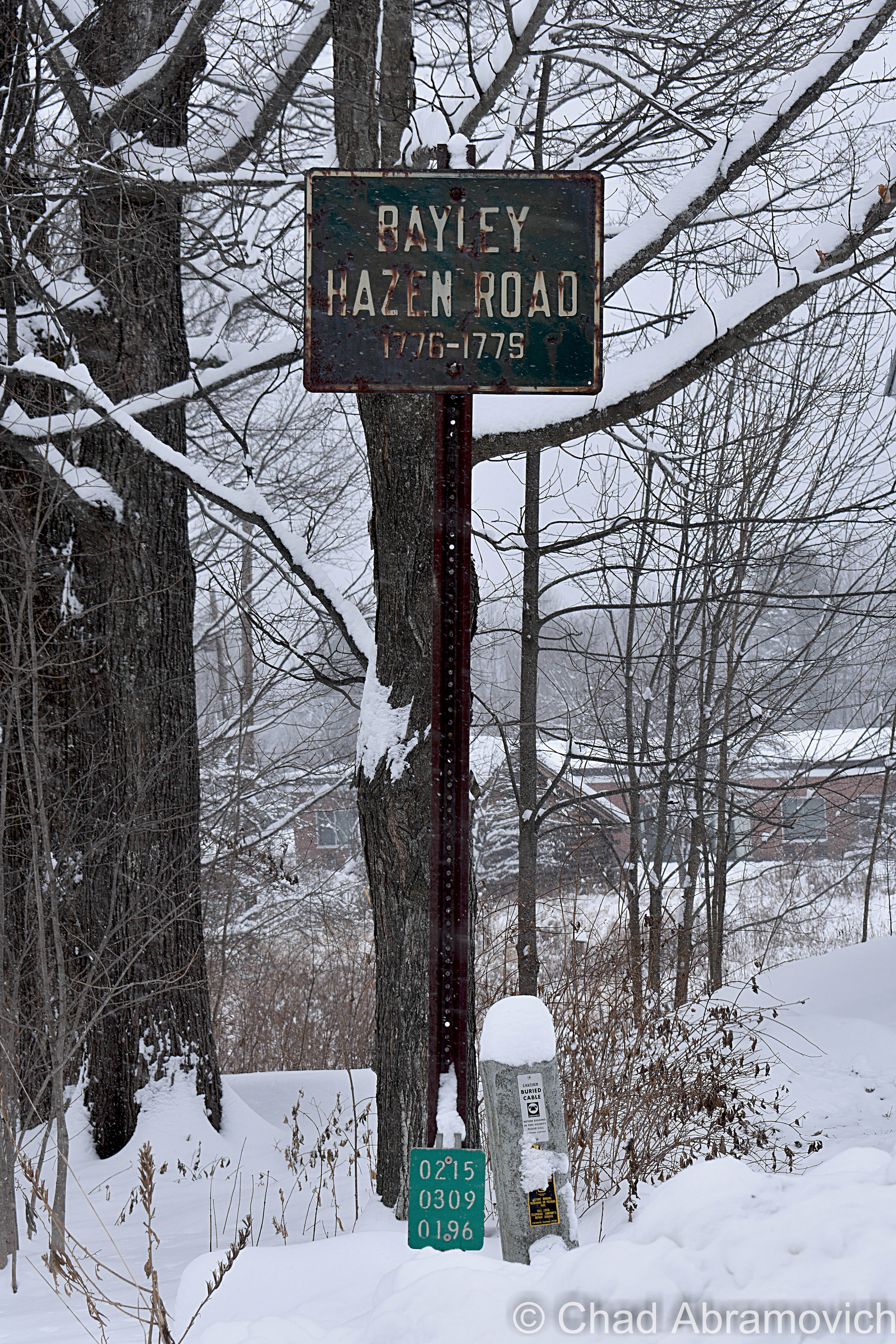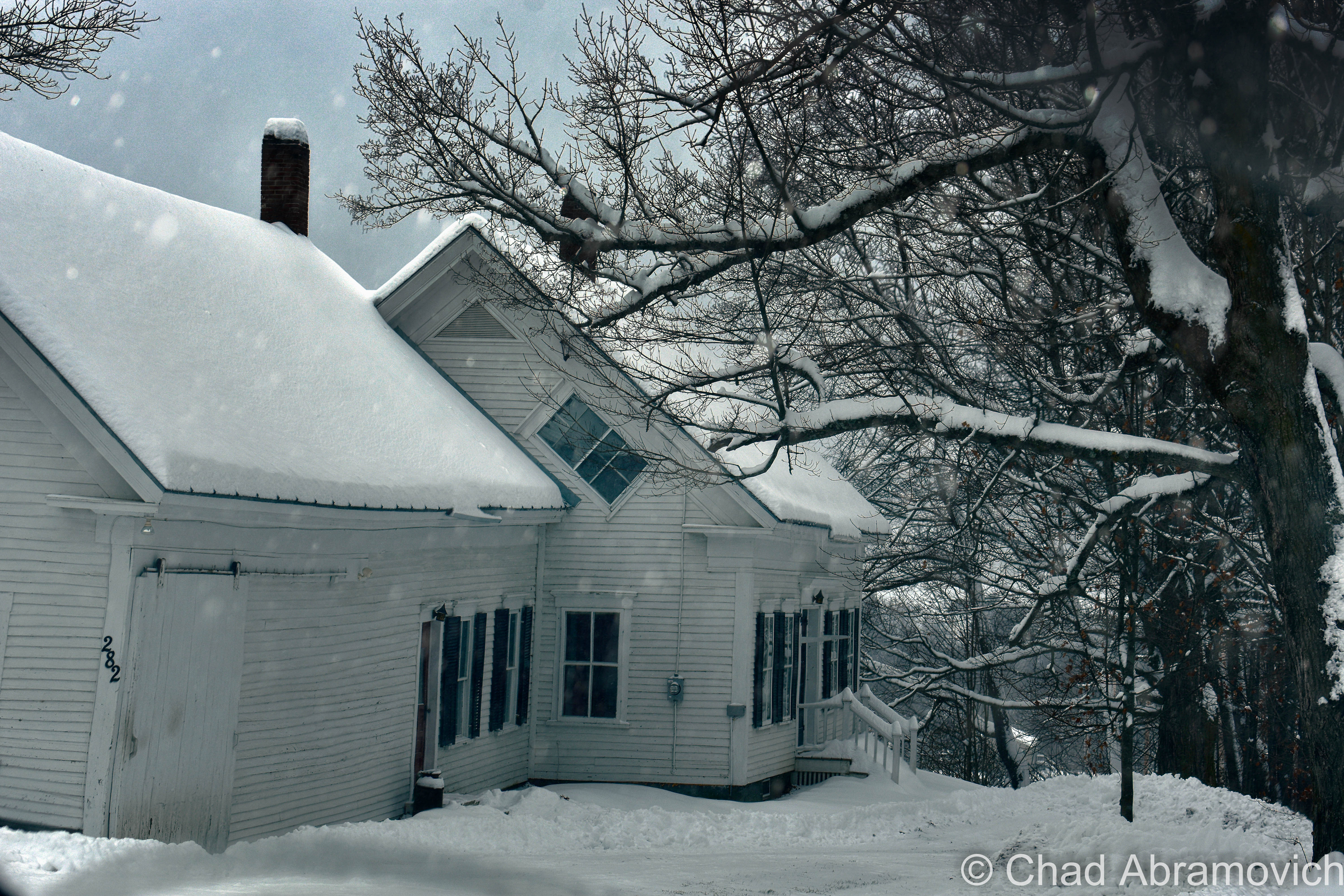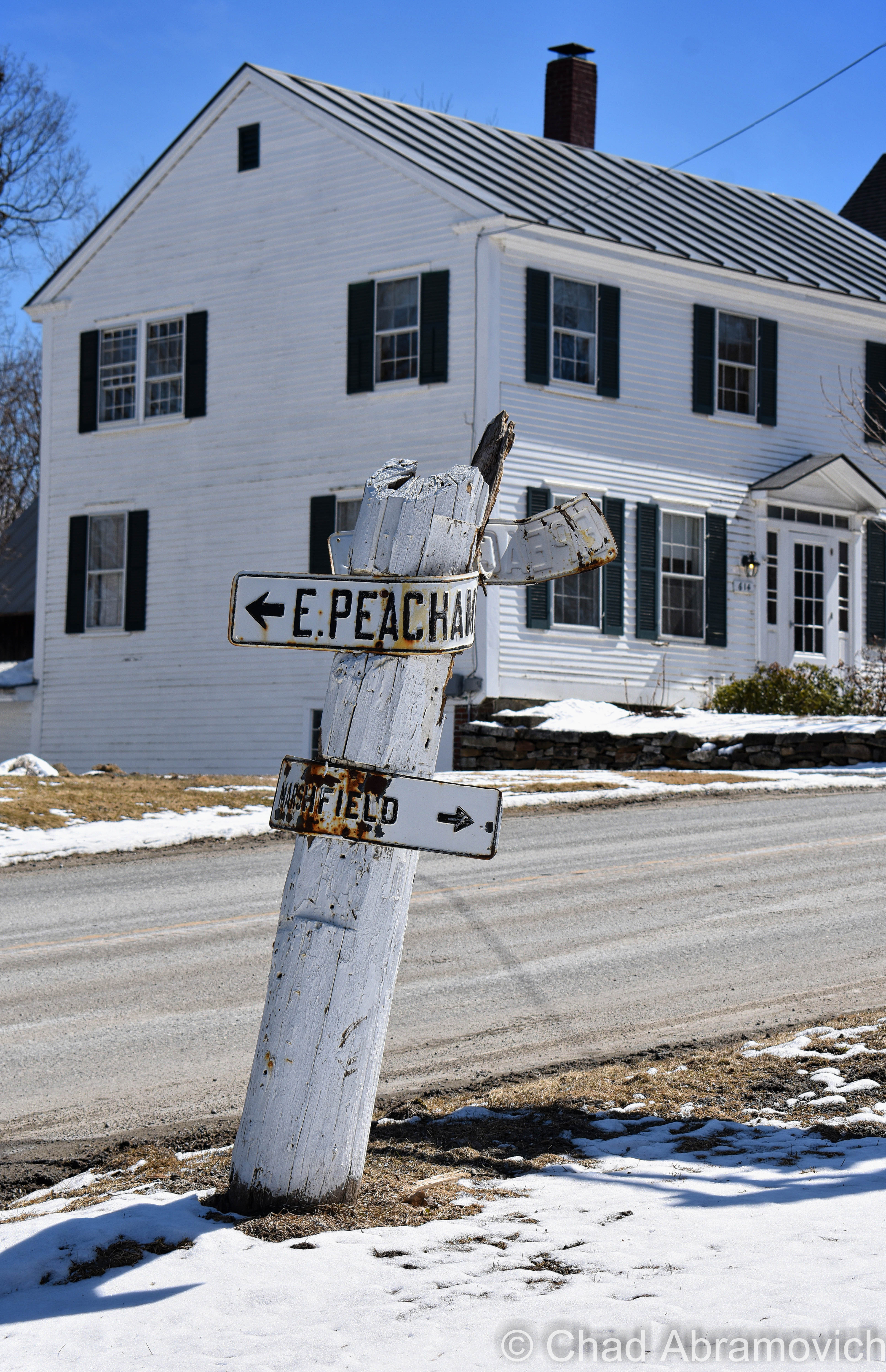Sometimes it’s fun to wander around an old New England boneyard, which occasionally contains products that chronical captivating calamities, violence, and curiosities that have long been running deep in New England’s granite hills and character.
There is actually an entire coterie of tombstone tourists who dig hanging out in cemeteries and marveling at what the dead went into creating. If you’ve been following my blog for a while, you know I’ve sojourned to a few cemeteries before, where I’ve tracked down everything from a grave with a curse, to a grave with a window.
In the postcard lauded NEK village of Peacham is a graveyard on a hill crest with a view, and inside is a quiet monument erected by guilt-burdened townsfolk over a century ago.
The increasingly hard to decipher text reads; Erected by the citizens of Peacham to the memory of Esther Emmons, aged 74, Mary Davis, aged 35, and Willie, aged 8 – a mother, daughter, and grandchild who perished in the snow on the night of March 5th AD, 1869, after traveling on foot nearly 15 miles during the day.

It was an appropriately miserable 7 degrees that day with a brutal wind as I drove into town on the cratered tarmac of the Bayley Hazen Road – one of Vermont’s most historic thoroughfares.
Commissioned by Colonel Jacob Bayley and General Moses Hazen in 1776, the idea was to slash a road from Wells River and head northwest through the frontier lands of northern Vermont up to the border, so the continental army would have a convenient route to invade Canada if they decided to put that on their to-do list.
But roads work in two directions. By 1779 they got as far as a gap in the Green Mountains now known as Hazen’s Notch (which is a great drive!) before they realized that the British army could also easily use the road to raid Vermont. Oops. Construction ceased, but what had already been laid down inadvertently opened up access to a corner of Vermont now known as the Northeast Kingdom that was previously incredibly hard to get to – places like what became known as Peacham.
Today, tons of kingdom towns have Bayley Hazen Roads – and you can still drive a huge chunk of the original military route as plotted in this cool pdf that would make a fun summer or autumn road trip for those of you who dig backroad expeditions like me.



This wasn’t the easiest marker to find. With some emailed guidance by the enthusiastic Stan Fickes of the Peacham Historical Society, I spotted my sought-after piece of memento-mori as the chill crept down my spine; an innocuous granite rectangle with subtly rounded top gouged with a weather-beaten eulogy that looked much like half the other graves here, and probably wouldn’t have grabbed my attention if I didn’t have an idea of what to detect.
This also might be one of the few instances where a re-cataloging of a cemetery came about due to a ghost story.
Mr. Fickes recalled an interesting personal story to me. Several years ago, he worked as the assistant town clerk. A local woman had stopped by one day and sheepishly came forward with a problem that isn’t complained about on the regular. She explained that they had bought an old house in town and had been living there for a few months now, but something was a bit… amiss.
She and her husband both admitted to feeling something in the house, something they described as “a presence”. This notion was solidified when they actually saw a woman inside their house, a woman in ‘Victorian’ garb that was trespassing in a corporal sense.
They started to ask around about the house’s history and discovered that a girl had drowned in their water supply cistern decades ago. They wanted to know more about the drowned girl and tracked down her name – which lead them to find her grave in the town cemetery. It dismally appeared that the girl had been buried by herself, with nothing that could be traced as her family anywhere near her plot. The story affected them on such a personal level that they would make several visits to her resting place over the years.
By chance, a cousin of the girl heard about their interest and stopped by the town clerk’s to convey more of the story. It turns out, her parents weren’t far away at all! They were actually buried right beside her, but they couldn’t afford to have their names added to the headstone.
However, none of this supposedly stopped any odd happenings at that house, even with a change of ownership over the years. But the search for the little girl’s grave and the noting of its additional occupants did inspire a revision of the cemetery index – which helped me find what I was looking for.
As I knelt down on the frozen grass and pulled my camera out of my bag, I couldn’t help thinking that I hope this will be a tale that hopefully inspires generosity in present-day Vermonters.
————————————————
Mrs. Esther Emmons was an impoverished widow and an employed servant on a well-to-do farm near Peacham. Her son had recently become disabled after an accident in the Vermont woods (sources vary; either he was a woodsman or a farm hand) left him crippled.
Having no way to bring in any income, he was indignantly left with no other choice but to apply to the town of Hardwick for assistance.
Mrs. Emmons walked the 20 miles from Peacham to Hardwick to see to her son. Her daughter, 35-year-old Mary Davis, and her grandson, 8-year-old Willie, agreed to fetch her later that day and make the walk back together.
But the appointed overseer of the poor, who was ironically lacking in sympathy, curtly told Mrs. Emmons that her son was her responsibility. There being nothing else she could do, she glumly rendezvoused with her daughter and grandson and embarked on the long walk back to Peacham.
It was calm when they set out – the cold coming at them like knives. By the time they reached north of Peacham, thick storm clouds drifted in and light flakes began to drop around them.
Arriving at the junction of Peacham woods, Mrs. Emmons was beginning to show signs of exhaustion, and the skies began to get ominous.
Assessing the situation, they decided to take the long way around – with the intent of seeking shelter at one of the farms they’d have to pass. That would surely be a safer bet than taking the little-traveled and undeveloped uphill road through the forest, which might be a fatal place to get stuck in such a big blizzard that was approaching.
The Bean farm came up first, but Mr. Bean, who apparently had a deficiency in social niceties, flat out turned them away.
Their hopes were picked up when they heard the clank of approaching sleighbells. A man in a one-horse sleigh was passing by and slowed down when he recognized Mrs. Emmons. He offered her a ride, but the sled couldn’t hold the weight of all 3 of them. Mrs. Emmons declined, saying that she was going to stay with her family. Surely the next house would take them in she reasoned.
The trio trudged onward. The storm’s fury was swelling into something that would make misery proud, and the night was finally tuning up, sending wet clumps of snow that clung to their bodies and a stinging wind that flung icy crystals into their faces.
They began to stop and embrace each other for warmth, and then keep moving forward a few more sluggish yards in the dark and sleet before repeating the process, until the form of the Stewart farmhouse came into their blurry sight.
Hope for a night’s lodging gave way to a dreadful surprise when Mr. Stewart brusquely and without an explanation, grunted “I’m taking no one in”, and slammed the door in their faces.
The incredulous family turned away and desperately attempted to reach the Farrow Farm down the road – who were known by many to be kindly folks.
But Mrs. Emmons’ strength had almost diminished, and now the stalwart matriarch, who had been their leader and navigator, was stumbling into rapidly gathering snowdrifts and greatly struggling to continue onwards. Mary and Willie desperately attempted to help her and drag her along, but hunger, fatigue, and the strangling cold was taking their toll on all of them.
Could they make it?
As you’ve already seen in my photograph, they sadly became confused, disoriented, worn down, and froze to death within 30 feet of safety.
The next morning, Peacham residents awoke to the mercury sinking to 24 below zero at the end of one of the worst snow storms in Vermont history and began the arduous process of digging themselves out from shoulder high drifts.
Townsfolk hitched up their oxen and sleds, formed teams, and set out to the seemingly impossible task of breaking through snow covered roads.
Then, Ben Kimball spotted something from his sled. Brightly covered cloth against the stark white of fresh powder. He slowed down to investigate and grimly discovered that the garment was attached to the corpse of an old woman. It was the widow Esther Emmons.
He called out for assistance, and soon, the crew made even more gruesome discoveries.
Another body, a younger woman who they recognized as Mary Davis, was found sitting against a stone wall where she’d frozen to death. Then they found eight-year-old Willie Davis nearby, who was poised upright as if he’d been fighting his way from the Farrow farmhouse through the storm back to his mother’s side. Judging by his tracks that were still visible in the snow, it looked like he had become disoriented, and for some reason had turned around. In some instances, he’d been crawling on his hands and knees.
Distressed spectators were able to put together the missing pieces. When Mrs. Emmons was no longer able to stand, Willie attempted to go for help. He was undoubtedly guided by a lighted window at the Farrow’s. But the boy had become confused and turned around just a few feet from shelter.
Later during questioning, Mr. Farrow admitted to turning out his light and going to bed around the same time he heard some sort of faint calls amid the howling storm. But then he disclosed a pretty gothic detail; he attributed the cries to his demented daughter who was locked away in a room upstairs and didn’t think much else of it.
Peachamites, caught in the gravity of failing to help their own, attempted to atone for their collective sins and decided to erect a modest monument out of humiliation.
Though it was ruled that no one was officially at fault, in the minds of most, it was cold-hearted Mr. Stewart who was to blame. Reportedly, he agreed with that sentiment and suffered horrendous guilt for the rest of his days.
Even on his deathbed, he still felt haunted by his callous actions on that dark event from 1869. As the tale goes, his body shivered violently as if from a terrible cold. He cried out that he was freezing, whether from delusion or perhaps, something more preternatural…
And though it was mid-July when he died, Mr. Stewart’s corpse was as cold as ice.
** Thank you to Stan Fickes of the Peacham Historical Society, who provided background information on this tragic tale and aided me in my cemetery safari.
Since 2012, I’ve been seeking out venerable examples of Vermont weirdness, whether that be traveling around the state or taking to my internet connection and digging up forsaken places, oddities, esoterica, and unique natural features. And along the way, I’ve been sharing it with you on my website, Obscure Vermont. This is what keeps my spirit inspired.
I never expected Obscure Vermont to get as much appreciation and fanfare as it’s getting, and I’m truly grateful and humbled. Especially in recent years, where I’ve gained the opportunity to interact with and befriend more oddity lovers and outside the box thinkers around Vermont and New England. As Obscure Vermont has grown, I’ve been growing with it, and the developing attention is keeping me earnest and pushing me harder to be more introspective and going further into seeking out the strange.
I spend countless hours researching, writing, and traveling to keep this blog going. Obscure Vermont is funded almost entirely by generous donations. Expenses range from hosting fees to keep the blog live, investing in research materials, travel expenses and the required planning, and updating/maintaining vital tools such as my camera and my computer. I really pride and push myself to try to put out the best of what I’m able to create, and I gauge it by only posting stuff that I personally would want to see on the glow of my computer screen.
I want to continuously diversify how I write and the odd things I write about. Your patronage would greatly help me continue bringing you cool and unusual content and keep me doing what I love!


